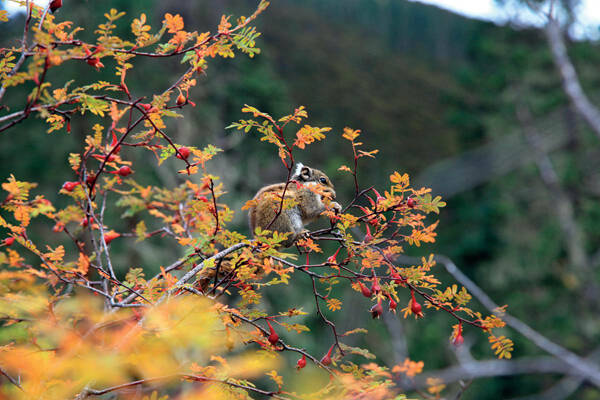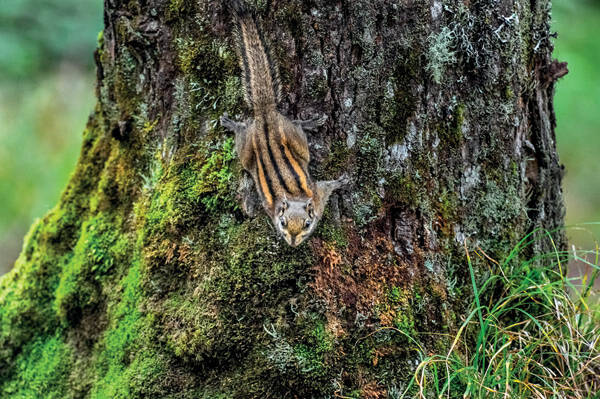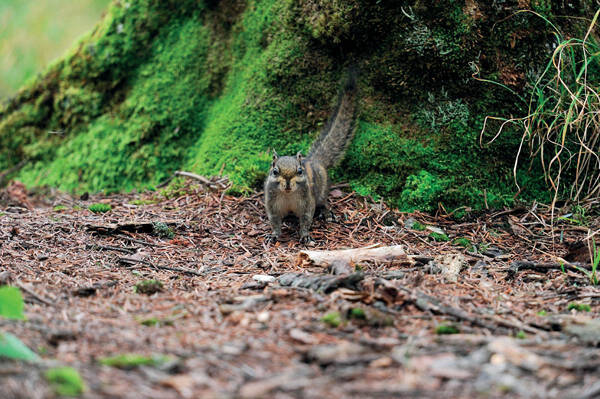Tamiops swinhoei
IUCN
LCBasic Information
Scientific classification
- name:Tamiops swinhoei
- Scientific Name:Tamiops swinhoei,Hidden flower squirrel, yellow-bellied flower squirrel, leopard mouse, chipmunk, golden chipmunk, three-browed squirrel, Diao Lingzi, etc.
- Outline:Rodents
- Family:Rodentia Sciuridae Squirrel
Vital signs
- length:About 13cm
- Weight:
- lifetime:
Feature
There is a distinct black stripe in the middle of the back, and two brown or light yellow vertical stripes on both sides.
Distribution and Habitat
In China, it is distributed in Tibet, Yunnan, Sichuan, Chongqing, Hebei, Henan, Shaanxi, Shanxi, Gansu, Ningxia, Hunan and Hubei. Abroad, it is distributed in Myanmar and Vietnam.
It lives in subtropical and temperate evergreen broad-leaved forests, coniferous forests and shrubs near farmland.
Appearance
This species is larger than other species in the genus Squirrel, and its fur is long and dense. These shape characteristics are related to the environment where this species lives at higher latitudes or higher altitudes. The back of the body is olive gray-yellow as a whole, with a dark brown vertical stripe in the center of the back, and gray-brown and yellow-white stripes on both sides. The side of the body is slightly lighter than the back, and the outer light stripes are lighter but wider than those of the chipmunk. The obvious difference from the clear-striped chipmunk is that the light-colored lines on the cheeks and the light-colored lines on the sides of the body are discontinuous at the sides of the neck and shoulders.
Details
The chipmunk, also known as the chipmunk, yellow-bellied chipmunk, and leopard mouse, usually builds nests in tree holes, tree branches, or cracks on cliffs. It is active at dawn and dusk. Its food is mainly plant fruits, buds, seeds, and insects. It is widely distributed and is a common group. It inhabits a wide range of forest types, mainly subtropical forests, often in forest edges and shrubs. Its vertical distribution is mainly at medium altitudes, generally at an altitude of 400 to 1,200 meters, and the highest is at 2,600 meters in oak forests.

The Hidden Flower Squirrel is an omnivorous animal. According to the observation and dissection of the stomach contents of six flower squirrels, they mainly feed on various seeds, young shoots, fir, pine nuts, chestnuts, lichens, bark and insects. In winter, they are occasionally seen eating dead rats. They can eat rice, noodles, egg yolks, pork and other residues near residential areas.
It takes an average of 9.9 seconds for a flower squirrel to eat once. When eating, its body is supported by its hind legs, and it picks up food with its mouth, holds it with its front legs and chews it. Sometimes it does not need the help of its front legs. After eating, it stays on the tree, chews or wipes the tree trunk with its mouth. In the 2-hour activity, the time spent on foraging is about 56 minutes, and the time spent on staying and playing on the tree is 61 minutes. The flower squirrel's food intake is almost equal to its activity frequency, so the allocation of its foraging time is related to its lack of cheek pouches and inability to temporarily store food.

Although the Hidden Flower Squirrel lives in trees, it often moves on the ground. It is usually most active in the early morning or dusk. It often moves alone or in groups of three or five. It also runs in groups on trees. The range of activities is not large. It often appears in orchards or vegetable gardens. It usually moves in a jumping manner. When climbing a tree trunk, it often climbs up the trunk in a zigzag shape. When descending a tree, it moves head down quickly to the base of the trunk and finally jumps to the ground. After or during feeding, it chases and plays with each other.
When avoiding enemies, the cryptic squirrel generally does not make a sound, but moves alertly and is always ready for enemies. Its actions are to quickly climb up the tree and immediately turn its head down to avoid the enemy's attack. If it is disturbed by humans, it will quickly crawl around the tree trunk or jump to another tree to escape the attack. Sometimes it is only a few centimeters off the ground and does not get off the ground.

The resting time of the hidden flower squirrel includes going back to the nest to sleep or stopping on the tree to bask in the sun. The posture on the branch is that the tail is naturally bent under the hind legs, the head is resting on the front legs, and the eyes are open; the posture on the tree trunk is that the body lies flat on the tree trunk, the tail and neck are straight, the front legs are spread out to the sides to grasp the tree trunk, or the front legs are retracted under the abdomen, and the hind legs are naturally straightened backwards. The latter often appears on trees with sunlight in winter and spring.
The nests of the hidden squirrels are often built in the forks or tree holes of fir trees, with the junction of the trunk and branches of the tree as the base, moss and fir bark as materials, and they build nests under tree roots or tree mats. Occasionally, they also use old bird nests or build nests in the grooves of roof tiles or eaves.

The hidden flower squirrel reproduces twice a year, once in spring and once in autumn. Each litter has 2 to 4 babies, and there are also 4 to 6 babies in one litter. The mating behavior is that the male chases the female from the ground to the tree. The two get close in the tree. The female does not move, the male takes the initiative to approach, sniffs her anus, and then hugs the female waist with his forelimbs. After a few seconds, the male quickly leaves. During the chase, the female and male individuals constantly make subtle "zhi-zhi" sounds. At the same time, the male often makes a "de luo" sound. The calls are all rapid. The males appear restless and look for females, which usually lasts for 3 to 5 minutes.








